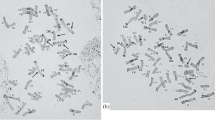Summary
The meiotic pairing behaviour at metaphase I of a Triticum aestivum×Triticum monococcum hybrid has been studied by means of the C-banding technique to ascertain the homology between the chromosomes in the A genome of the two species. The technique allowed the A and B genome chromosomes and the 2D, 3D and 5D chromosomes to be identified. Differences in the level of chromosome pairing in the A genome were noted. The T. monococcum 4A chromosome did not pair with any of the T. aestivum chromosomes in any of the metaphase I cells analysed. Two reciprocal translocations between the 2B and 2D chromosomes on one side and the 2A and 3D on the other side have been identified. The usefulness of the C-banding technique in the study of chromosome homology among species related to wheat is discussed.
Similar content being viewed by others
References
Cauderon, Y., 1986. Cytogenetics in breeding programmes dealing with polyploidy, interspecific hybridization and introgression. In: Genetic Manipulation in Plant Breeding. Walter de Gruyter & Co. Berlin & New York, pp. 83–104.
Chapman, V., T.E.Miller & R.Riley, 1976. Equivalence of the A genome of bread wheat with that of Triticum urartu. Genet. Res. 27: 69–76.
Chapman, V. & R.Riley, 1966. The allocation of the chromosomes of Triticum aestivum to the A and B genomes and evidence of genome structure. Can. J. Genet. Cytol. 8: 57–63.
Dosba, F. & G.Doussinault, 1978. Création de lignées de blé présentant des caractéristiques agronomiques favorables d'Aegilops ventricosa. Ann. Amélior. Plantes 28: 27–44.
Dvorak, J., 1976. The relationship between the genome of Triticum urartu and the A and B genomes of Triticum aestivum. Can. J. Genet. Cytol. 18: 371–377.
Dvorak, J., 1983. The origin of wheat chromosomes 4A and 4B and their genome reallocation. Can. J. Genet. Cytol. 25: 210–214.
Dvorak, J., P.E.McGuire & B.Cassidy, 1988. Apparent sources of the A genomes of wheats inferred from polymorphism in abundance and restriction fragment length of repeated nucleotide sequences. Genome 30: 680–689.
Dvorak, J., P.Resta & R.S.Kosta, 1990. Molecular evidence on the origin of wheat chromosomes 4A and 4B. Genome 33: 30–39.
Ferrer, E., J.M.González & N.Jouve, 1984. Identification of C-banded chromosomes in meiosis of common wheat, Triticum aestivum L. Theor. Appl. Genet. 67: 257–261.
Friebe, B., N.S.Kim, J.Kuspira & B.S.Gill, 1990. Genetic and cytogenetic analyses of the A genome of Triticum monococcum VI. Production and identification or primary trisomic using the C-banding technique. Genome 33: 542–555.
Giorgi, B. & A.Bozzini, 1969. Karyotype analysis in Triticum. III. Analysis of the presumed diploid progenitors of polyploid wheats. Caryologia 22: 279–306.
Hart, G.E. & M.D.Gale, 1990. Biochemical/molecular loci in hexaploid wheat. In: Genetics maps; locus maps of complex genomes. 5th ed. Edited by S.J.O'Brien. Cold Spring Harbor Laboratory, Cold Spring Harbor, N.Y. pp. 6.28–6.38.
Johnson, B.L., 1975. Identification of the apparent B-gemone donor of wheat. Can. J. Genet. Cytol. 17: 21–39.
Jouve, N., N.Diez & M.Rodriquez, 1980. C-banding in 6x triticale × Secale cereale L. hybrid cytogenetics. Theor. Appl. Genet. 57: 75–79.
Kerber, E.R. & P.L.Dyck, 1973. Inheritance of stem rust resistance transferred from diploid wheat (Triticum monococcum) to tetraploid and hexaploid wheat and chromosomes location of the gene involved. Can. J. Genet. Cytol. 15: 397–409.
Kerby, K. & J.Kuspira, 1987. The phylogeny of the polyploid wheats Triticum aestivum (bread wheat) and Triticum turgidum (macaroni wheat). Genome 29: 722–737.
Kerby, K. & J.Kuspira, 1988. Biochemical data bearing on the relationship between the genome of Triticum urartu and the A and B genomes of the polyploid wheats. Genome 30: 576–581.
Kihara, H., 1919. Über cytologische Studien bei einigen Getreidearten. Mit. I Spezies-bastard des Weizen und Weizenroggen-bastarde. Bot. Mag. 33: 17–38.
Kihara, H., 1924. Cytologische und genetische Studien bei wichtigen Getreidearten mit besonderer Rücksicht auf des Verhaler der Chromosomen und die Sterilität in den Bastardt. Mem. Cell. Sci. Kyote Imp. Univ. 1: 1–200.
Kihara, H., 1944. Die Entdeckung der DD Analysatoren beim Weizen. Agric. Hort. 19: 889–890.
Konarev, V.G., 1983. The nature and origin of wheat genomes on the data of grain protein immunochemistry and electrophoresis. Proceeding of the 6th International Wheat Genetics Symposium. Kyoto, Japan. pp. 65–75.
Kuspira, J., J.Maclagan, K.Kerby & R.N.Bhambhani, 1986. Genetic and cytogenetic analysis of the A genome of Triticum monococcum II. The mode of inheritance of spring versus winter growth habit. Can. J. Genet. Cytol. 28: 88–95.
McFadden, E.S. & E.R.Sears, 1944. The artificial synthesis of Triticum spelta. Rec. Genet. Soc. Am. 13: 26–27.
McFadden, E.S. & E.R.Sears, 1946. The origin of Triticum spelta and its free-threshing hexaploid relatives. J. Hered. 37: 107–116.
McIntosh, R.A., P.L.Dyck, T.T.The, J.E.Cusick & D.L.Milne, 1984. Cytogenetical studies in wheat. XIII Sr 35 a third gene from Triticum monococcum for resistance to Puccinia graminis tritici. Z. Pflanzenzüchtg 92: 1–14.
Melburn, M.C. & W.P.Thompson, 1927. The cytology of tetraploid wheat hybrid (Triticum spelta×T. monococcum). Am. J. Bot. 14: 327–333.
Miller, T.E. & S.M.Reader, 1980. Variation in the meiotic chromosome pairing of hybrids between hexaploid and diploid wheats. Cereal Res. Com. 8: 477–483.
Multani, D.S., H.S.Dhalival, S.K.Sharma & K.S.Gill, 1989. Inheritance of isoproturol tolerance in durum wheat transferred from Triticum monococcum. Plant Breeding 102: 166–168.
Naranjo, R., A.Roca, P.G.Goicoechea & R.Giráldez, 1987. Arm homoeology of wheat and rye chromosomes. Genome 29: 873–882.
Nisikawa, K., 1983. Species relationship of wheat and its putative ancestors as viewed from isozyme variation. Proceeding of the 6th International Wheat Genetics Symposium, Kyoto, Japan. pp. 59–63.
Takumi, S., S.Nasuda, Y.G.Liu & Tsunewaki, 1991. Nuclear genome differentiation between three species of einkorn wheat as revealed by RFLP analysis of nuclear DNA. Jpn. J. Breed. 41: 464–465.
Author information
Authors and Affiliations
Rights and permissions
About this article
Cite this article
González, J.M., Bernard, S. & Bernard, M. Metaphase-I analysis of a Triticum aestivum x T. monococcum hybrid by the C-banding technique. Euphytica 68, 187–192 (1993). https://doi.org/10.1007/BF00029872
Received:
Accepted:
Issue Date:
DOI: https://doi.org/10.1007/BF00029872



